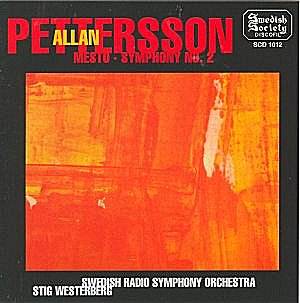For most of the 1960s and 1970s Pettersson's
only commercial recording representation came from Swedish Society
Discofil. When Harold Moores had their sale during the autumn
of 1979 I bought those three LPs. The Mesto was coupled
with excerpts from Sibelius's Tempest music, symphonies
2 and 7 were on separate albums. Of this immersion I confess to
finding at the time little to grip me in the Mesto or in
the forbidding Second Symphony. The LPs were cheap and stacked
high so I felt little real disappointment even if I did regret
the money spent on the still inexplicable Bengt Hambraeus electronic
music disc. Such disappointment as there may have been was offset
anyway by picking up LPs of Nystroem's Sinfonia del Mare and
his Sinfonia Concertante - both of which spent many hours
on my turntable.
The Mesto is the slow movement
of the monumental Concerto for No. 3 for strings. It can be heard
in full context with the other two Pettersson string concertos
on CPO 999 225-2. Do not look for humour in this music. If it
is there it wears a crooked and unstable smile. This is music
grave and stressed with vinegary Sibelian wraiths intimated at
18.48. That does not stop it being varied and indeed Pettersson's
trademark trudging and pattering rhythmic figures are there. So
are the keening acidic violins and the ruthlessly cycling baritonal
commentary of the violas and cellos. Its forty years show only
in the friable sound at the very start. (By the way it should
not be too long before Intim-Musik issue their CD of the two Nystroem
concertos for strings).
The Second Symphony was written in Paris
behind the back of his teacher René Leibowitz (whose Beethoven
symphony cycle is on Chesky). It was created in the basement of
the Swedish Church. This is of about the same dimensions as the
Seventh Symphony and is also in a single movement. This is almost
unrelentingly the work of a nightmare depressive. Searing shreds
of Tchaikovskian string writing (Pathétique), Bergian
lyrical material, the scarred emotions of the Fourth symphonies
of Sibelius and Shostakovich (not that he would have known the
latter work) are refracted through a harsh surrealism - a dark
night of the soul indeed. There is some placid balm as at 8.10,
13.15. 29.48 but it is in short supply and brutally cut short
each time or shrivelled into gloom. There are some delicate moments
in this music but it is often as if Ravel's Ma Mère
l'Oye had been doused in acid. There is anger too in this
music. Memorable moments include the fluttered vulnerable and
stabbing trumpet fanfares at 28.10. Indeed a sharp thrust from
the trumpets ushers the work towards its close. The tenderness
of the Seventh Symphony is foreshadowed at 39.00 - a moment of
consolation which true to form is soon napalmed by Pettersson's
despairing reality. There is some analogue hiss but rarely do
you notice this.
I keep hoping that Discofil will rescue from
vinyl oblivion three Pettersson recordings that never made it
to CD. There is the Sony LP (76553) of the Sixth Symphony where
the Swedish Radio Symphony Orchestra were conducted by Okko Kamu.
The Philips double LP set (6767 951) of the Ninth Symphony in
which the Goteborg Symphony Orchestra were conducted by Sergiu
Comissiona. Also ripe for licensing if DG agree is the similarly
Comissiona/Baltimore LP of the Eighth Symphony (Polar/DG 2531
176). On these late 1970s discs the Pettersson revival, brought
to fruition by CPO and Bis, was built. No doubt the licensing
negotiations would be arduous but the artistic rewards from these
pioneering discs would be high.
Not the place to start your Pettersson pilgrimage,
for that you need the magnificent Dorati version of the Seventh
also on Discofil. This is instead gritty, uncompromising and uningratiating,
where structural demands are seemingly alien and where spontaneity
and responsiveness to the moment leads the listener through a
fearsome realm.
Pettersson enthusiasts must have this disc as
a record of the vivid and excoriating imagination of Pettersson,
Westerberg and the Swedish Society pioneers.
Rob Barnett
